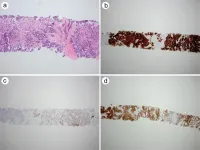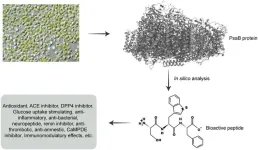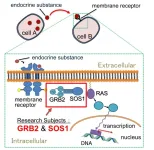Expression of carbonic anhydrase IX as a novel diagnostic marker for differentiating pleural mesothelioma from non-small cell lung carcinoma
2024-10-26
(Press-News.org) Background and objectives
Mesothelioma is an aggressive tumor with a poor prognosis. Histological diagnosis of mesothelioma using limited tissue samples can be challenging. Carbonic anhydrase IX (CAIX) is a transmembrane protein that is overexpressed in a variety of solid tumors. This study aimed to investigate the clinical utility of CAIX expression in the differential diagnosis of pleural mesothelioma from non-small cell lung carcinoma (NSCLC).
Methods
Unstained tissue microarray slides composed of 56 cases of pleural mesothelioma and 82 cases of NSCLC were subjected to immunohistochemical staining using a mouse anti-human antibody against CAIX.
Results
Of the 38 epithelioid mesothelioma cases, 34 (89%) displayed diffuse and strong cytoplasmic membrane reactivity, while the remaining four cases (11%) showed weak to moderate staining in tumor cells. Five out of sixteen (5/16) sarcomatoid mesothelioma cases were negative. Among the non-small cell lung carcinoma cases, 76% (32/42) of adenocarcinomas and 57% (21/37) of squamous cell carcinomas were completely negative, whereas the remaining cases showed focal weak expression of CAIX.
Conclusions
Our study demonstrates that CAIX expression has a high sensitivity (100%) in detecting pleural epithelioid mesothelioma, which is comparable to or better than currently used mesothelial markers. The specificity of CAIX is within a comparable range to that of commonly used mesothelial markers for differentiating epithelioid mesothelioma from NSCLC. Therefore, we recommend that CAIX immunohistochemistry staining be considered as an additional tool for the differential diagnosis of mesothelioma, particularly pleural epithelioid mesothelioma, from its common mimicker, NSCLC.
Full text
https://www.xiahepublishing.com/2771-165X/JCTP-2024-00029
The study was recently published in the Journal of Clinical and Translational Pathology.
Journal of Clinical and Translational Pathology (JCTP) is the official scientific journal of the Chinese American Pathologists Association (CAPA). It publishes high quality peer-reviewed original research, reviews, perspectives, commentaries, and letters that are pertinent to clinical and translational pathology, including but not limited to anatomic pathology and clinical pathology. Basic scientific research on pathogenesis of diseases as well as application of pathology-related diagnostic techniques or methodologies also fit the scope of the JCTP.
Follow us on X: @xiahepublishing
Follow us on LinkedIn: Xia & He Publishing Inc.
END
[Attachments] See images for this press release:

ELSE PRESS RELEASES FROM THIS DATE:
2024-10-26
Background and objectives
Chlorella vulgaris is a green, photosynthetic microalga in the phylum Chlorophyta. The goal of our study was to perform a bioinformatics analysis of Photosystem I P700 chlorophyll a apoprotein A2, one of its photosynthesis-related proteins, and to hunt for potent bioactive peptides.
Methods
To generate peptides and estimate the safety and efficacy of each bioactive peptide, we employed the tools BIOPEP-UWM™, PeptideRanker, DBAASP, and ToxinPred. PepDraw was used to understand the physicochemical properties ...
2024-10-26
Background and objectives
Helicobacter pylori (H. pylori) infection can cause multiple secondary digestive disorders. Some studies have found that polymorphisms in Toll-like receptor (TLR) genes, including TLR10 rs10004195, may be associated with increased susceptibility to H. pylori infection. Despite conflicting reports, we conducted a meta-analysis to clarify the relationship between these factors.
Methods
We conducted an exhaustive review, encompassing all relevant literature up to February 2024, using databases ...
2024-10-26
Background and objectives
Nail psoriasis is common in patients with plaque psoriasis and is associated with morbidity, including onychomycosis, which can complicate psoriasis treatments and be difficult to differentiate. Matrix-assisted laser desorption/ionization time-of-flight (MALDI-TOF) mass spectrometry is a fast and simple technique for identifying microorganisms through protein analysis. This study aimed to determine the sensitivity and specificity of MALDI-TOF for diagnosing onychomycosis in patients with nail psoriasis, by using conventional mycological and histological methods as the reference standard.
Methods
A prospective study was conducted on 88 patients with ...
2024-10-26
Background and Aims
Alpha-1 antitrypsin deficiency (AATD) is a genetic disorder characterized by the misfolding and accumulation of the mutant variant of alpha-1 antitrypsin (AAT) within hepatocytes, which limits its access to the circulation and exposes the lungs to protease-mediated tissue damage. This results in progressive liver disease secondary to AAT polymerization and accumulation, and chronic obstructive pulmonary disease (COPD) due to deficient levels of AAT within the lungs. Our goal was to characterize the unique effects of COPD secondary to AATD on liver disease and gene expression.
Methods
A ...
2024-10-26
Background and Aims
The effect of tenofovir amibufenamide (TMF) on blood lipid profiles in patients with chronic hepatitis B (CHB) remains unclear. This study aimed to explore whether TMF affects blood lipids during 48 weeks in patients with CHB.
Methods
A total of 91 patients with CHB undergoing TMF treatment for 48 weeks were divided into two groups: Lipid Normal (n = 42) and Lipid Abnormal (n = 49), based on baseline blood lipid levels. Lipid indices, virological responses, and biochemical indicators were compared between the two groups. Clinical observations were ...
2024-10-26
Tokyo, Japan – Researchers from Tokyo Metropolitan University have uncovered new insights into how the proteins GRB2 and SOS1 in cells pass signals from membrane receptors to nuclei. They used nuclear magnetic resonance (NMR) to study how and which specific regions of GRB2 and SOS1 bind to each other, especially how they trigger liquid-liquid phase separation (LLPS). Issues with signal transduction are a major cause of cancers: understanding how it works may lead to radical new treatments.
Biological ...
2024-10-26
San Diego, CA (October 25, 2024) — Glucagon-like peptide-1-receptor agonists (GLP-1RA) are medications that are increasingly prescribed for patients with type 2 diabetes and congestive heart failure. Reports of GLP-1RA–associated acute kidney injury (AKI) have emerged, but the risk of GLP-1RA–associated AKI among patients on anti-cancer drugs is unclear. Surprisingly, new research suggests that taking GLP-1RA is not associated with an increased risk of AKI in patients receiving anti-cancer therapies. The findings will be presented at ASN Kidney Week 2024 October 23– 27.
For the study, investigators analyzed ...
2024-10-26
San Diego, CA (October 25, 2024) — Prior efforts to identify novel kidney biomarkers as risk factors for chronic kidney disease (CKD) progression have typically evaluated proteins individually, which limits their prognostic power. The National Institute of Diabetes and Digestive and Kidney Diseases’ (NIDDK’s) CKD Biomarkers Consortium of investigators recently developed and tested novel dimensions of kidney health by combining a set of 17 urine and plasma biomarkers that ...
2024-10-26
San Diego, CA (October 25, 2024) — IgA nephropathy (IgAN) is an autoimmune kidney disease driven by immune cells that express a protein called CD38 on their surface. A recent Phase 2 trial revealed that felzartamab, an investigational anti-CD38 monoclonal antibody, helps to reduce proteinuria and maintain patients’ kidney function. Investigators evaluated the molecular mechanisms underlying felzartamab’s potential efficacy in IgAN. The findings will be presented at ASN Kidney Week 2024 October 23– 27.
It is hypothesized that CD38+ cells ...
2024-10-26
San Diego, CA (October 25, 2024) — Sodium-glucose co-transporter 2 (SGLT2) inhibitors reduce the risk of cardiovascular and kidney outcomes in patients with type 2 diabetes, but it is unclear whether their effects differ based on patients’ age. A recent analysis of clinical trial data reveals that the SGLT2 inhibitor canagliflozin benefited patients across all age categories. The findings will be presented at ASN Kidney Week 2024 October 23 – 27.
The analysis pooled individual participant data from the CANVAS Program and CREDENCE trial and assessed efficacy and safety according to baseline age. ...
LAST 30 PRESS RELEASES:
[Press-News.org] Expression of carbonic anhydrase IX as a novel diagnostic marker for differentiating pleural mesothelioma from non-small cell lung carcinoma


